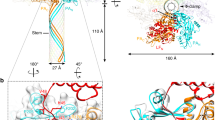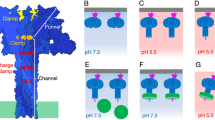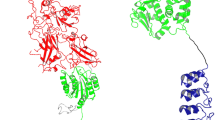Abstract
The protein transporter anthrax lethal toxin is composed of protective antigen (PA), a transmembrane translocase, and lethal factor (LF), a cytotoxic enzyme. After its assembly into holotoxin complexes, PA forms an oligomeric channel that unfolds LF and translocates it into the host cell. We report the crystal structure of the core of a lethal toxin complex to 3.1-Å resolution; the structure contains a PA octamer bound to four LF PA-binding domains (LFN). The first α-helix and β-strand of each LFN unfold and dock into a deep amphipathic cleft on the surface of the PA octamer, which we call the α clamp. The α clamp possesses nonspecific polypeptide binding activity and is functionally relevant to efficient holotoxin assembly, PA octamer formation, and LF unfolding and translocation. This structure provides insight into the mechanism of translocation-coupled protein unfolding.
This is a preview of subscription content, access via your institution
Access options
Subscribe to this journal
Receive 12 print issues and online access
$189.00 per year
only $15.75 per issue
Buy this article
- Purchase on Springer Link
- Instant access to full article PDF
Prices may be subject to local taxes which are calculated during checkout





Similar content being viewed by others
References
Wickner, W. & Schekman, R. Protein translocation across biological membranes. Science 310, 1452–1456 (2005).
Navon, A. & Ciechanover, A. The 26 S proteasome: from basic mechanisms to drug targeting. J. Biol. Chem. 284, 33713–33718 (2009).
Sauer, R.T. et al. Sculpting the proteome with AAA+ proteases and disassembly machines. Cell 119, 9–18 (2004).
Cheng, Y. Toward an atomic model of the 26S proteasome. Curr. Opin. Struct. Biol. 19, 203–208 (2009).
Young, J.A. & Collier, R.J. Anthrax toxin: receptor binding, internalization, pore formation, and translocation. Annu. Rev. Biochem. 76, 243–265 (2007).
Matouschek, A. Protein unfolding—an important process in vivo? Curr. Opin. Struct. Biol. 13, 98–109 (2003).
Krantz, B.A., Finkelstein, A. & Collier, R.J. Protein translocation through the anthrax toxin transmembrane pore is driven by a proton gradient. J. Mol. Biol. 355, 968–979 (2006).
Krantz, B.A. et al. A phenylalanine clamp catalyzes protein translocation through the anthrax toxin pore. Science 309, 777–781 (2005).
Thoren, K.L., Worden, E.J., Yassif, J.M. & Krantz, B.A. Lethal factor unfolding is the most force-dependent step of anthrax toxin translocation. Proc. Natl. Acad. Sci. USA 106, 21555–21560 (2009).
Kenniston, J.A., Baker, T.A., Fernandez, J.M. & Sauer, R.T. Linkage between ATP consumption and mechanical unfolding during the protein processing reactions of an AAA+ degradation machine. Cell 114, 511–520 (2003).
Martin, A., Baker, T.A. & Sauer, R.T. Pore loops of the AAA+ ClpX machine grip substrates to drive translocation and unfolding. Nat. Struct. Mol. Biol. 15, 1147–1151 (2008).
Huang, S., Ratliff, K.S. & Matouschek, A. Protein unfolding by the mitochondrial membrane potential. Nat. Struct. Biol. 9, 301–307 (2002).
Huang, S., Ratliff, K.S., Schwartz, M.P., Spenner, J.M. & Matouschek, A. Mitochondria unfold precursor proteins by unraveling them from their N-termini. Nat. Struct. Biol. 6, 1132–1138 (1999).
Smith, H. & Keppie, J. Observations on experimental anthrax: demonstration of a specific lethal factor produced in vivo by Bacillus anthracis. Nature 173, 869–870 (1954).
Friedlander, A.M. Macrophages are sensitive to anthrax lethal toxin through an acid-dependent process. J. Biol. Chem. 261, 7123–7126 (1986).
Agrawal, A. & Pulendran, B. Anthrax lethal toxin: a weapon of multisystem destruction. Cell. Mol. Life Sci. 61, 2859–2865 (2004).
Ezzell, J.W. & Abshire, T.G. Serum protease cleavage of Bacillus anthracis protective antigen. J. Gen. Microbiol. 138, 543–549 (1992).
Milne, J.C., Furlong, D., Hanna, P.C., Wall, J.S. & Collier, R.J. Anthrax protective antigen forms oligomers during intoxication of mammalian cells. J. Biol. Chem. 269, 20607–20612 (1994).
Kintzer, A.F. et al. The protective antigen component of anthrax toxin forms functional octameric complexes. J. Mol. Biol. 392, 614–629 (2009).
Petosa, C., Collier, R.J., Klimpel, K.R., Leppla, S.H. & Liddington, R.C. Crystal structure of the anthrax toxin protective antigen. Nature 385, 833–838 (1997).
Katayama, H. et al. GroEL as a molecular scaffold for structural analysis of the anthrax toxin pore. Nat. Struct. Mol. Biol. 15, 754–760 (2008).
Kintzer, A.F. et al. Role of the protective antigen octamer in the molecular mechanism of anthrax lethal toxin stabilization in plasma. J. Mol. Biol. 399, 741–758 (2010).
Pannifer, A.D. et al. Crystal structure of the anthrax lethal factor. Nature 414, 229–233 (2001).
Lacy, D.B., Wigelsworth, D.J., Melnyk, R.A., Harrison, S.C. & Collier, R.J. Structure of heptameric protective antigen bound to an anthrax toxin receptor: a role for receptor in pH-dependent pore formation. Proc. Natl. Acad. Sci. USA 101, 13147–13151 (2004).
Benson, E.L., Huynh, P.D., Finkelstein, A. & Collier, R.J. Identification of residues lining the anthrax protective antigen channel. Biochemistry 37, 3941–3948 (1998).
Krantz, B.A., Trivedi, A.D., Cunningham, K., Christensen, K.A. & Collier, R.J. Acid-induced unfolding of the amino-terminal domains of the lethal and edema factors of anthrax toxin. J. Mol. Biol. 344, 739–756 (2004).
Van den Berg, B. et al. X-ray structure of a protein-conducting channel. Nature 427, 36–44 (2004).
Lum, R., Niggemann, M. & Glover, J.R. Peptide and protein binding in the axial channel of Hsp104. Insights into the mechanism of protein unfolding. J. Biol. Chem. 283, 30139–30150 (2008).
Wang, J. et al. Crystal structures of the HslVU peptidase-ATPase complex reveal an ATP-dependent proteolysis mechanism. Structure 9, 177–184 (2001).
Zimmer, J., Nam, Y. & Rapoport, T.A. Structure of a complex of the ATPase SecA and the protein-translocation channel. Nature 455, 936–943 (2008).
Hinnerwisch, J., Fenton, W.A., Furtak, K.J., Farr, G.W. & Horwich, A.L. Loops in the central channel of ClpA chaperone mediate protein binding, unfolding, and translocation. Cell 121, 1029–1041 (2005).
Levchenko, I., Grant, R.A., Flynn, J.M., Sauer, R.T. & Baker, T.A. Versatile modes of peptide recognition by the AAA+ adaptor protein SspB. Nat. Struct. Mol. Biol. 12, 520–525 (2005).
Levchenko, I., Grant, R.A., Wah, D.A., Sauer, R.T. & Baker, T.A. Structure of a delivery protein for an AAA+ protease in complex with a peptide degradation tag. Mol. Cell 12, 365–372 (2003).
Cunningham, K., Lacy, D.B., Mogridge, J. & Collier, R.J. Mapping the lethal factor and edema factor binding sites on oligomeric anthrax protective antigen. Proc. Natl. Acad. Sci. USA 99, 7049–7053 (2002).
Arora, N. & Leppla, S.H. Residues 1–254 of anthrax toxin lethal factor are sufficient to cause cellular uptake of fused polypeptides. J. Biol. Chem. 268, 3334–3341 (1993).
Arora, N. & Leppla, S.H. Fusions of anthrax toxin lethal factor with shiga toxin and diphtheria toxin enzymatic domains are toxic to mammalian cells. Infect. Immun. 62, 4955–4961 (1994).
Milne, J.C., Blanke, S.R., Hanna, P.C. & Collier, R.J. Protective antigen-binding domain of anthrax lethal factor mediates translocation of a heterologous protein fused to its amino- or carboxy-terminus. Mol. Microbiol. 15, 661–666 (1995).
Lacy, D.B., Mourez, M., Fouassier, A. & Collier, R.J. Mapping the anthrax protective antigen binding site on the lethal and edema factors. J. Biol. Chem. 277, 3006–3010 (2002).
Lacy, D.B. et al. A model of anthrax toxin lethal factor bound to protective antigen. Proc. Natl. Acad. Sci. USA 102, 16409–16414 (2005).
Melnyk, R.A. et al. Structural determinants for the binding of anthrax lethal factor to oligomeric protective antigen. J. Biol. Chem. 281, 1630–1635 (2006).
Chauhan, V. & Bhatnagar, R. Identification of amino acid residues of anthrax protective antigen involved in binding with lethal factor. Infect. Immun. 70, 4477–4484 (2002).
Meador, W.E., Means, A.R. & Quiocho, F.A. Target enzyme recognition by calmodulin: 2.4 A structure of a calmodulin-peptide complex. Science 257, 1251–1255 (1992).
Meador, W.E., Means, A.R. & Quiocho, F.A. Modulation of calmodulin plasticity in molecular recognition on the basis of x-ray structures. Science 262, 1718–1721 (1993).
Blanke, S.R., Milne, J.C., Benson, E.L. & Collier, R.J. Fused polycationic peptide mediates delivery of diphtheria toxin A chain to the cytosol in the presence of anthrax protective antigen. Proc. Natl. Acad. Sci. USA 93, 8437–8442 (1996).
Christensen, K.A., Krantz, B.A. & Collier, R.J. Assembly and disassembly kinetics of anthrax toxin complexes. Biochemistry 45, 2380–2386 (2006).
Clackson, T. & Wells, J.A. A hot spot of binding energy in a hormone-receptor interface. Science 267, 383–386 (1995).
Landry, S.J. & Gierasch, L.M. The chaperonin GroEL binds a polypeptide in an alpha-helical conformation. Biochemistry 30, 7359–7362 (1991).
Li, Y., Gao, X. & Chen, L. GroEL recognizes an amphipathic helix and binds to the hydrophobic side. J. Biol. Chem. 284, 4324–4331 (2009).
Wang, Z., Feng, H., Landry, S.J., Maxwell, J. & Gierasch, L.M. Basis of substrate binding by the chaperonin GroEL. Biochemistry 38, 12537–12546 (1999).
Duesbery, N.S. et al. Proteolytic inactivation of MAP-kinase-kinase by anthrax lethal factor. Science 280, 734–737 (1998).
Adams, P.D. et al. Recent developments in the PHENIX software for automated crystallographic structure determination. J. Synchrotron Radiat. 11, 53–55 (2004).
MacDowell, A.A. et al. Suite of three protein crystallography beamlines with single superconducting bend magnet as the source. J. Synchrotron Radiat. 11, 447–455 (2004).
Otwinowski, Z. & Minor, W. Processing of X-ray diffraction data collected in oscillation mode. Methods Enzymol. 276, 307–326 (1997).
Storoni, L.C., McCoy, A.J. & Read, R.J. Likelihood-enhanced fast rotation functions. Acta Crystallogr. D Biol. Crystallogr. 60, 432–438 (2004).
Emsley, P. & Cowtan, K. COOT: model-building tools for molecular graphics. Acta Crystallogr. D Biol. Crystallogr. 60, 2126–2132 (2004).
Davis, I.W. et al. MolProbity: all-atom contacts and structure validation for proteins and nucleic acids. Nucleic Acids Res. 35, W375–W383 (2007).
Pettersen, E.F. et al. UCSF Chimera—a visualization system for exploratory research and analysis. J. Comput. Chem. 25, 1605–1612 (2004).
Mogridge, J., Cunningham, K. & Collier, R.J. Stoichiometry of anthrax toxin complexes. Biochemistry 41, 1079–1082 (2002).
Acknowledgements
We thank H. Gong, E. Haddadian, T. Sosnick and K. Freed for assistance in refining the backbone torsional angles using their unpublished TOP algorithm; J. Colby for assistance in purifying constructs; M. Brown for constructing the pET15-LFN-SalI vector; J. Berger and N. Echols for advice on crystallography; R. Zalpuri at the Robert D. Ogg Electron Microscope Laboratory; J. Holton and G. Meigs at the 8.3.1 beamline of the Advanced Light Source; and T. Sosnick, J. Collier, J. Berger and J. Kuriyan for helpful advice. This work was supported by University of California start-up funds (B.A.K.) and US National Institutes of Health research grants R01-AI077703 (B.A.K.) and R01-GM064712 (E.R.W.).
Author information
Authors and Affiliations
Contributions
G.K.F. crystallized, solved and refined the PA8(LFN)4 structure. G.K.F., K.L.T., H.J.S., A.F.K., S.G.G. and I.I.T. obtained functional data. G.K.F., K.L.T., H.J.S., A.F.K., E.R.W. and B.A.K. prepared the manuscript.
Corresponding author
Ethics declarations
Competing interests
The authors declare no competing financial interests.
Supplementary information
Supplementary Text and Figures
Supplementary Methods, Supplementary Figures 1–12 and Supplementary Table 1 (PDF 1558 kb)
Rights and permissions
About this article
Cite this article
Feld, G., Thoren, K., Kintzer, A. et al. Structural basis for the unfolding of anthrax lethal factor by protective antigen oligomers. Nat Struct Mol Biol 17, 1383–1390 (2010). https://doi.org/10.1038/nsmb.1923
Received:
Accepted:
Published:
Issue Date:
DOI: https://doi.org/10.1038/nsmb.1923
This article is cited by
-
Targeting the Inside of Cells with Biologicals: Toxin Routes in a Therapeutic Context
BioDrugs (2023)
-
Atomic structures of anthrax toxin protective antigen channels bound to partially unfolded lethal and edema factors
Nature Communications (2020)
-
Molecular assembly of lethal factor enzyme and pre-pore heptameric protective antigen in early stage of translocation
Journal of Molecular Modeling (2016)
-
Translocation of Non-Canonical Polypeptides into Cells Using Protective Antigen
Scientific Reports (2015)
-
Atomic structure of anthrax protective antigen pore elucidates toxin translocation
Nature (2015)



